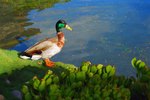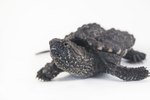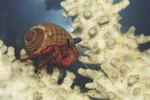
Amphibians appeared about 370 million years ago and were the first vertebrates to walk on land. Meanwhile, the first reptiles -- which gave rise to dinosaurs, lizards, birds and even the first mammals -- appeared in the Carboniferous period, about 360 million years ago to 300 million years ago. It was during this period that the amniotic egg developed, giving creatures domination of the terrestrial landscape to the present.
The Amphibian Egg
The amphibian egg -- termed anamniotic -- is largely similar to the fish egg. The egg is composed of a series of jellylike layers that protect the developing embryo from desiccation, pathogens and, to a limited extent, predators. Surrounding the embryo is a structure called the vitelline membrane. Oxygen and carbon dioxide diffuse passively through this structure, enabling the developing frog or salamander to breathe. Because of the lack of an outer shell, the egg must be deposited in the water or a very damp location to prevent drying out.
The Amniotic Egg
In contrast to the simple anamniotic or amphibian egg, the amniotic egg contains a number of distinct structures. At the innermost part of the egg, the embryo is suspended by the amniotic fluid, which is surrounded by a membrane called the amnion. The allantois deals with waste and gas exchange and, together with the nutritious egg yolk, connects to and partially surrounds the embryo. The chorion surrounds all of these structures and separates them from the albumin -- the egg whites. All of these components are enclosed in an outer shell. The shell is calcified in most lizards, snakes, turtles, birds and crocodilians; however, animals who give birth to live young enclose their young in non-calcified flexible shells that rupture near the time of birth.
Amniotic Freedom
Whereas most frogs and salamanders are bound to waterscapes for reproductive purposes, the development of the amniotic egg allowed creatures to venture far from the water. As animals did this, they filled empty niches on land that weren't accessible to the amphibians. These animals are also better able to protect their eggs, as they can bury them or place them in hidden locations. Once on land, further diversification took place as the animals adapted to a plethora of terrestrial food sources; amniotes could eat terrestrial plants; perhaps more importantly, the insects that had already colonized the land.
Varying Fertilization
Most frogs and salamanders engage in external fertilization; as a female deposits eggs in the water, the male releases sperm to fertilize them. The development of amniotic eggs freed animals from having to deposit their eggs in the water, but it came at a cost: External fertilization of shelled eggs is not possible. The shell of a reptile's egg is impervious to sperm, so the eggs must be fertilized before they have formed this layer and are deposited. This caused "intromittent" organs to evolve, allowing males to internally fertilize females.
References
- Kimball's Biology Page: Frog Embryology
- To Breathe or Not to Breathe: Whaaaat ... Eggs Breathe? How Amphibian and Fish Eggs Exchange Gases
- To Breathe or Not to Breathe:Whaaaat ... Eggs Breathe? Part II: How Bird, Reptile and Monotreme Eggs Exchange Gases
- Edge of Existence: Ancient Amphibians
- University of California Museum of Palentology: The Carboniferous Period
- University of California Museum of Palentology: Introduction to the Amniota
Photo Credits
-
Ablestock.com/AbleStock.com/Getty Images




